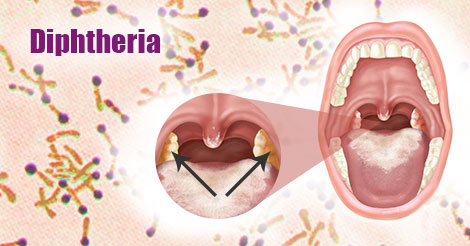Diphtheria, a potentially lethal infection caused by Corynebacterium diphtheriae, primarily affects the upper respiratory tract and is transmitted through respiratory droplets or close contact. In cases of suspected or confirmed exposure, timely prophylactic intervention is critical to prevent disease progression and interrupt transmission chains.

Transmission and Pathophysiology
Mode of Transmission
- Airborne via respiratory droplets
- Direct contact with skin lesions
- Contact with contaminated personal items (e.g., towels, utensils)
Incubation Period
- Typically 2 to 5 days
- Can extend up to 10 days depending on host factors
Disease Mechanism
Diphtheria toxin binds to host cell receptors, inhibiting protein synthesis and leading to local tissue necrosis, systemic toxicity, and complications such as myocarditis and neuritis.
Immediate Post-Exposure Response Strategy
1. Identification of Close Contacts
A “close contact” includes:
- Household members
- Individuals sharing meals or sleeping quarters
- Medical personnel exposed without PPE
- Anyone with prolonged face-to-face exposure
2. Risk Stratification and Symptom Monitoring
Contacts should be assessed for:
- Vaccination status
- Symptoms such as sore throat, fever, or nasal discharge
- Underlying health conditions
3. Isolation Measures
Symptomatic individuals should be isolated immediately pending laboratory confirmation and treatment.
Prophylactic Measures for Diphtheria Exposure
Antibiotic Prophylaxis
Close contacts of diphtheria cases should receive a full 7–10 day course of appropriate antibiotics.
Recommended Regimens
- Erythromycin: 500 mg orally four times daily (or pediatric equivalent)
- Penicillin G benzathine: 600,000 units IM (children <6); 1.2 million units IM (≥6 years)
Purpose
- Eradicates potential colonization
- Prevents asymptomatic carriage and secondary transmission
Vaccination Protocol
Td or Tdap Booster
All contacts with uncertain or incomplete immunization history should receive a booster dose of diphtheria-containing vaccine.
Indications Based on Age
- <7 years: Administer DTaP or DT
- ≥7 years: Administer Tdap or Td
Vaccination Timeline
- Administer booster immediately after exposure if no documented dose in the last 5 years
Diphtheria Antitoxin (DAT) and Clinical Use
Indications for Antitoxin
Post-exposure diphtheria prevention in symptomatic individuals is not complete without the administration of diphtheria antitoxin.
Mechanism of Action
Neutralizes circulating diphtheria toxin before it enters cells.
Dosage and Administration
- Administer intravenously based on severity and site of infection
- Sensitivity testing required prior to administration due to risk of anaphylaxis
Public Health Measures and Surveillance
Contact Tracing
Efficient identification and evaluation of close contacts is critical. Public health departments must initiate immediate epidemiological investigations and establish a line-list of exposed individuals.
Lab Testing and Culture
- Nasopharyngeal and throat swabs should be collected from all contacts
- Culture and PCR testing confirm the presence of toxigenic C. diphtheriae
Return to Community Clearance
Asymptomatic carriers require two negative cultures, 24 hours apart, taken after completing antibiotics to be cleared from isolation.
Considerations for Special Populations
Infants and Young Children
- Use age-appropriate vaccines (DTaP preferred)
- Monitor closely for airway obstruction and dehydration
Pregnant Women
- Tdap vaccine is safe during pregnancy, ideally during the third trimester
- Antibiotic prophylaxis aligns with standard adult regimens
Immunocompromised Individuals
- Require close monitoring due to potential reduced vaccine efficacy
- Antitoxin use must be individualized
Long-Term Follow-Up
Booster Dose Scheduling
Ensure future boosters at recommended intervals (every 10 years for adults) to maintain immunity.
Public Awareness
Educational campaigns should reinforce vaccination compliance, especially in outbreak-prone regions.
Data Reporting
All cases and contacts must be reported to national surveillance systems to track outbreaks and immunity gaps.
Frequently Asked Questions:
What is the most effective diphtheria post-exposure strategy?
A combination of antibiotics, vaccination, and clinical monitoring forms the core of effective post-exposure prevention.
Can vaccinated individuals become carriers?
Yes. Vaccinated individuals may carry the bacteria without symptoms and still transmit it, hence the need for antibiotic prophylaxis.
When is the diphtheria antitoxin used?
It is used only for symptomatic cases, not for prophylaxis in asymptomatic contacts.
How soon should antibiotics be started after exposure?
Ideally within 24 hours of confirmed contact for maximum preventive effect.
Is there a test to confirm immunity after vaccination?
Yes, serologic testing for antitoxin levels can indicate protective immunity but is rarely required in routine cases.
Effective post-exposure diphtheria prevention requires rapid identification of close contacts, immediate antibiotic prophylaxis, targeted vaccination strategies, and public health coordination. Preventing secondary transmission and safeguarding vulnerable populations depend on strict adherence to clinical guidelines and prompt action. With comprehensive protocols in place, we can significantly reduce the incidence and severity of diphtheria outbreaks.

